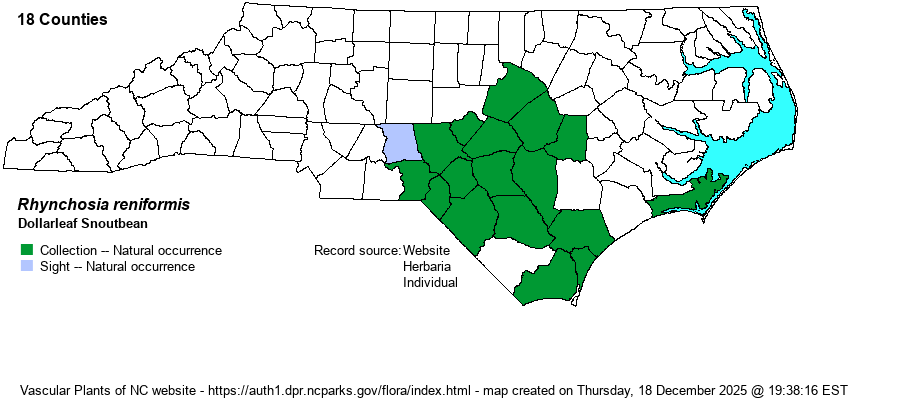| Author | de Candolle | |
| Distribution | Present over the southwestern third to half of the Coastal Plain, though mostly in the Sandhills region. Ranges eastward to Carteret County and several other coastal counties to the south, north to Wake County, and west to Montgomery and Richmond counties.
This is a Coastal Plain species ranging north only to southern NC, and south to southern FL and west to eastern TX. | |
| Abundance | Common in the Sandhills region; fairly common to locally common in the southern coastal areas (such as Pender and Brunswick counties). Infrequent to locally fairly common elsewhere in the central part of this area, including east to Carteret County. The NCNHP's State Rank of S3 is woefully conservative, and the editors suggest that S4 is more appropriate. | |
| Habitat | This is a characteristic herb of Longleaf Pine (Pinus palustris) sandhills, in a variety of settings. It prefers dry and normally sandy soil, and is most often seen in pine/scrub oak sandhill habitats, sometimes alsao into loamy sands of bean dips. | |
| Phenology | Blooms from June to September, and fruits from August to October. | |
| Identification | This is an odd-looking legume, perhaps not resembling a legume at all to inexperienced observers. It has an "erect" stem, but basically this is very short, and the handful of leaves appear to be basal and practically coming out of the ground at the base. Not only that, but the leaves are unifoliate (not divided into 3 leaflets like other native species in the genus) and quite rounded, about 1.5-2 inches across and wide, some being almost kidney-shaped. The petioles are often as long or longer than the leaf blade (to 3 inches long), and the leaves look wrinkled due to the strongly imprinted (sunken) veins on the upper leaf surface. The flowers grow in tight bunches at the base of the plant; each is yellow and about 1/2-inch across, but the pea-shape of them should give away the fact that this indeed is a legume. The other two native Rhynchosia species have trifoliate leaves, whereas the exotic R. americana -- extremely rare in the state -- is unifoliate but is a trailing vine-like plant. R. reniformis should be found fairly often on walks in the Sandhills preserves and managed areas, and it should be easily identified even without the flowers owing to the rounded leaves with deeply-sunken veins. | |
| Taxonomic Comments | None
| |
| Other Common Name(s) | Dollarweed, Dollarleaf, Roundleaf Snoutbean. A number of references use "Dollarleaf", but that is often used for Desmodium rotundifolium as well. The group common name for Rhynchosia is generally "snoutbean", and thus Dollarleaf Snoutbean, as used by a few references, seems best. | |
| State Rank | S3 [S4] | |
| Global Rank | G5? | |
| State Status | | |
| US Status | | |
| USACE-agcp | | |
| USACE-emp | | |

